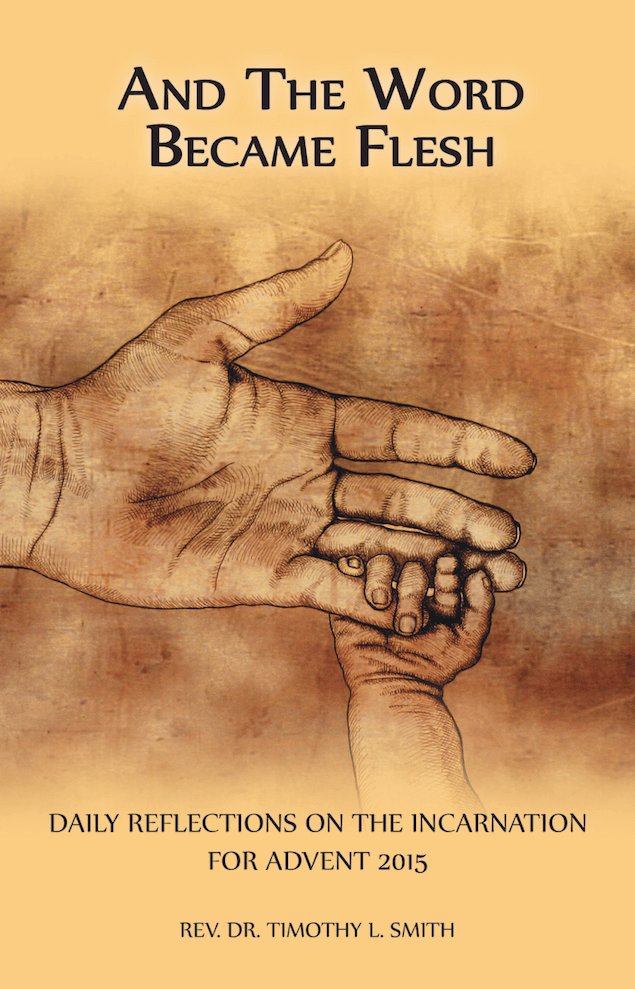The Ninth Day of Advent
In the days of his flesh, Jesus offered up prayers and supplications, with loud cries and tears, to the one who was able to save him from death, and he was heard because of his reverent submission. Although he was a Son, he learned obedience through what he suffered; and having been made perfect, he became the source of eternal salvation for all who obey him.
Hebrews 5:7-9
I have not always thought of Jesus as needing to learn a thing. He is, after all, “God from God, Light from Light, true God from true God.” (Nicene Creed) Why would an all knowing, omniscient, all wise God ever need to learn anything? And yet we know that Jesus is the Word become flesh. “He is truly human so that He not only resembles us men; He is the same as us.” (Karl Barth quoted in The Westminster Handbook to Karl Barth, ed. Richard E. Burnett)
This means that in His humanity Jesus needed to learn how to crawl, to stand up, and then to walk. The one who created the cosmos needed to learn how to hold His cup, how to write His name, and how to read the very Scriptures written about Him. As an apprentice at Joseph’s side He needed to learn how to measure and cut a board straight.
Luke’s Gospel hints at Jesus’ measured, steady growth into manhood: He was “obedient” to Mary and Joseph and “increased in wisdom and stature, and in favor with God and man.” (Luke 2:51-52). Jesus did not increase in wisdom in His divine nature, for He was omniscient, but He did increase in wisdom in His human nature. Jesus grew wiser and wiser. Nazareth neighbors likely said to Mary, “That boy of yours is really growing up to be a fine young man!” Jesus learned and matured.
Yet, I am struck by today’s Scripture revealing how Jesus “learned obedience”. This does not mean that Jesus was previously disobedient, but that He learned obedience by obeying. He walked this earth learning first what it meant to obey Mary and Joseph, and then ultimately what it meant as a human being to obey His Heavenly Father.
Remarkably our text says that Jesus learned obedience “through what he suffered”. Even though He was the Son of God suffering was necessary to teach Him obedience. In the school of suffering He learned an experiential knowledge of what it means to be human. He had to endure all the suffering that any human has ever endured. And through obedience learned in suffering He was made “perfect”. It is not that Jesus was ever imperfect, but that His suffering perfectly prepared Him to become “the source of eternal salvation”.
The word translated as “perfect” is the Greek word teleios: “a thing was teleios if it perfectly carried out the purpose for which it was designed.” (William Barclay, Daily Study Bible) Jesus’ suffering ‘perfectly’ fitted Him to become our Savior. He knows us perfectly and understands us. He has taken all our suffering and sin to Himself.
Centuries before, the Old Testament prophet Isaiah foretold the sufferings of Jesus and how the Father would use those sufferings to perfect Him as our Savior:
The Lord God has given me the tongue of a teacher, that I may know how to sustain the weary with a word. Morning by morning he wakens— wakens my ear to listen as those who are taught. The Lord God has opened my ear, and I was not rebellious, I did not turn backward. I gave my back to those who struck me, and my cheeks to those who pulled out the beard; I did not hide my face from insult and spitting (Isaiah 50:4-6).
God never promises that great faith will spare His children suffering. If the heavenly Father taught His beloved Son obedience through what He suffered, we ought never despise suffering. It is a tool of instruction in our lives.
PONDERINGS
- How do you picture Jesus growing in “in wisdom and stature, and in favor with God and man”? What does this say to you about Jesus?
- What are some ways in which Jesus suffered physically, emotionally, relationally, and spiritually?
- How do you think your suffering might be a tool of instruction?
EMBODIED PRAYER: KNEELING
“When the wise men found the baby Jesus, they knelt down and paid him homage” (Matthew 2:11). Many times throughout Scripture and the life of the church we find people kneeling to express their thoughts and feelings. English theologian David Peterson describes the impact of kneeling as we pray:
…an expression of inferior status and subservience to another person. Sometimes this obeisance was an indication of gratitude and sometimes it was associated with supplication or entreaty. Whatever the situation it was a recognition of total dependence of one party on another for the provision of some need…Sometimes it was associated with an outburst of praise, but sometimes the gesture itself appears to have been sufficient to express the trust and gratitude of those concerned. (David Peterson, Engaging with God: A Biblical Theology of Worship)
Sometimes people kneel to pray:
- Eyes open
- Looking up
- Hands lifted upward
Sometimes people kneel to pray:
- Looking downward with eyes averted or closed
- Hands folded
Today and every day of the Second Week of Advent pray the Lord’s Prayer while kneeling.



